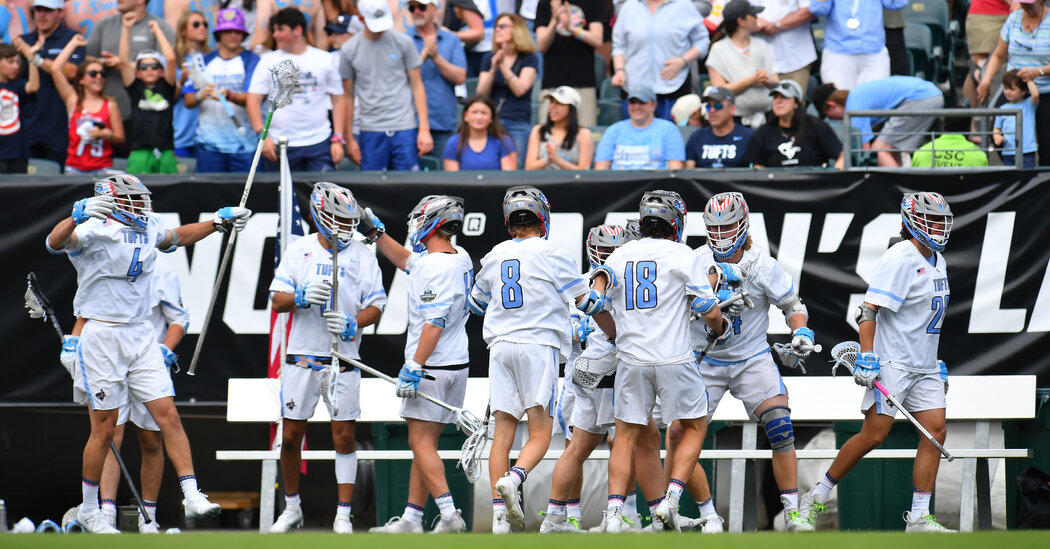An active-duty Navy SEAL who led a grueling training session for the Tufts University men’s lacrosse team last year that led to the hospitalization of nine students did not appear to be qualified for that role, according to a review commissioned by the university that was released on Friday.
Twenty-four of the 61 students who participated in the voluntary workout developed rhabdomyolysis, also known as rhabdo, a serious and somewhat rare muscle condition, the review said.
The president and athletics director of Tufts, which won the Division III men’s lacrosse championship a few months before the September 2024 training session, acknowledged in a statement on Friday that the session had not been appropriate.
“We would like to extend our sincere apologies to the members of the men’s lacrosse team, their families, and others affected by this situation,” Sunil Kumar, the university’s president, and John Morris, the athletics director, said.
The university, in Medford, Mass., outside of Boston, declined to name the Navy SEAL involved in the exercise regimen, other than to say that he had recently graduated from Tufts and was an equipment manager for the lacrosse team.
He did not cooperate with two independent investigators who prepared the report, according to its executive summary.
“To our knowledge, the third party who led the Navy SEAL workout did not have any credentials that qualified him to design, lead or supervise group exercises,” the summary said.
The review was conducted by Rod Walters, a sports medicine consultant, and Randy J. Aliment, a lawyer who specializes in internal investigations for universities and assessments of student-athlete safety and health.
The Naval Special Warfare Command, which oversees the SEAL program, did not immediately respond to a request for comment on Friday.
At the time of the episode, a spokeswoman for the command said that the SEAL was not at Tufts as part of a Navy-sanctioned event, and it was unclear if the sailor would face any disciplinary action.
During the 75-minute workout, lacrosse players and two other students did a series of repetitions focused almost exclusively on upper extremity muscle groups, including about 250 burpees, according to the review.
Popular with the military and in CrossFit gyms, burpees can involve quickly squatting down, jumping into a plank, performing a push-up, jumping forward into a squat, then jumping back into a standing position. But they have also been blamed for causing injuries when done incorrectly or quickly.
The review found that the university’s director of sports performance approved the workout plan the same day that he received it from the Navy SEAL and did not share it with others in the athletics department in advance.
The sports performance director, who was not named in the review, texted the plan to his staff about an hour before the students began the workout.
In the report, the investigators found that the Navy SEAL who led the training had lacked familiarity with N.C.A.A. policies and regulations and did not follow the principles of acclimatization that are necessary to avoid injury during training.
The review also faulted the university for its response to the situation, saying that there were no policies or procedures in place for transportation of students to and from hospitals, or direction of care from a medical perspective.
About 40 percent of the students who participated in the training sessions completed the exercises, but the majority had to modify the routine because of its difficulty, the report’s executive summary said.
“By the next morning, students began experiencing adverse effects and reported to the team athletic trainer,” the investigators wrote. “Two days later, several cases of Exertional Rhabdomyolysis had been identified.”
High-intensity workouts can cause rhabdo, as can trauma like a car crash or a fall, medical experts say. It involves injuries to skeletal muscles, leading the muscles to die and release their contents into the bloodstream.
Although rhabdo is an uncommon condition that affects about 26,000 people a year in the United States, according to the Cleveland Clinic, it can be life-threatening.
In 2011, 13 University of Iowa football players were hospitalized with rhabdo when the team jumped back into workouts after taking some time off following a bowl game. In recent years, there have been reports of a women’s soccer team in Texas suffering from rhabdo, which left one player hospitalized.
Guidelines developed several years ago by the N.C.A.A. that are aimed at preventing rhabdo said that college athletes should be given “transition periods” after a break in training or introducing new members to a team.
During transition periods, the N.C.A.A. recommends, athletic trainers and coaches should ensure that intensity and volume of activity is gradually increased over time.
Sara Ruberg contributed reporting.





